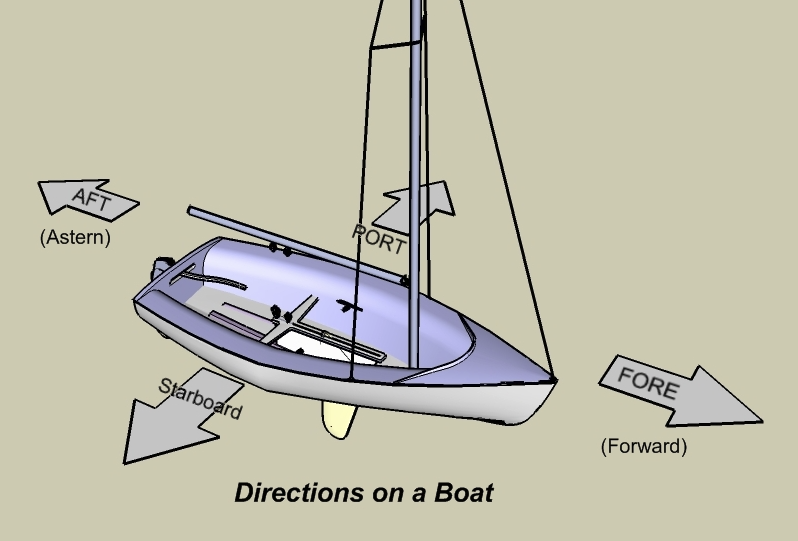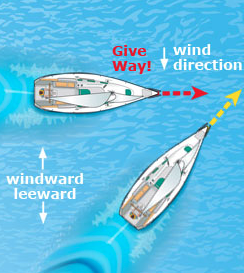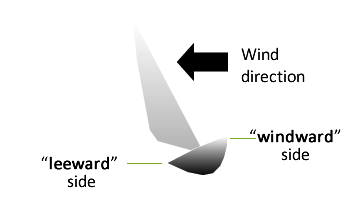Nautical Terminology 101 – Direction on a Boat
August 8th, 2023 by team

by B.J. Porter (Contributing Editor)
Directions on a boat can be tricky, because they’re not always absolute. Sometimes they are, and the mnemonics help you, but other times you’ve got to know the context to get it.
But don’t worry, we’ll take you from the basics to the ones that make you think “Up? So what the heck direction does that mean I turn the wheel?”
Fixed and Absolute Directions
Terms like right and left change references depending on the perspective of the speaker or viewer. Your right hand is always your right hand. But if you’re looking for something “to your right” what you’re looking at changes with the direction you’re facing. The fix on board is to make some references absolute.

Fore and Aft
These are simple because they sound like their non-nautical counterparts.
Fore is forward on the boat, aft is the rear. The parts of the boat are the bow (fore) and stern (aft). But when used to give directions to find things, like “the winch is just aft of the cheek block” you know it is behind the block towards the back of the boat. Assuming you know what a cheek block is, it’s easy to find that winch.
We may also combine fore and aft into other words, like forepeak, foretriangle, and afterdeck. The prefix gives you some idea where the thing is located.
Port and Starboard
Facing the bow while on the boat, the port side of the boat is always to the left and the starboard is on your right. This never changes. The port side is always the port side, no matter which way you or the boat are facing, whether you are looking at the boat from on it or outside it. To find the port side, face foreward and look to your left.
There are a few clever tricks to remember this until it’s permanently ingrained.
- “Port wine is red” works if you can look at the running lights. The red light is always on the port side of the boat, the green is on the starboard. Telltales on a sail also follow this scheme.
- “Port” and “Left” have the same number of letters. From there, you should be able to deduce starboard because it has no relation to “right” like that.
- Count the R’s – “Starboard is right.” Starboard has more Rs in it than port, so is “right.”
Before the invention of the rudder, ships turned with a steering board or oar. By convention, this was on the right side of the boat, which became the “steering board.” Linguistic change moved “steer board” to “starboard.” Since the steering oar was on the right, it also meant ships came into docks on the other side, the “port side.” But that wasn’t always the common term.
The port side was called “Larboard” into the mid-19th century. In 1844, the British Navy officially started using port instead of larboard, since it was easy to confuse starboard and larboard in a loud fray. Most of the English-speaking sailors followed in the coming decades.
What tack am I on?
On board you’ll hear discussions about being on “Starboard tack” or “Port tack.” This means the wind is coming over that side of the boat. On starboard tack, the wind comes from the starboard side, and the sails and boom are on the port side of the boat.
Knowing what tack you’re on is important to determine the right of way when two sailing boats meet. There’s rarely a concern out cruising, but it’s critical to know when racing!
In racing, the tack is technically determined by the side of the boom. So you could sail so far downwind that the wind is on the port side of the boat, but so is the boom – this is called “by the lee.” In that situation, the boat is still on port tack!
Relative Directions

The boat is a fixed object in oceans of fluids – both water and air. The wind direction is crucial to sailors, but it’s always changing. And it routinely flips from side to side, but what you do on the particular sides doesn’t really change.
Windward and Leeward

To windward is the side of the boat the wind is currently coming over. The leeward side…pronounced “loo-erd”… is the other one.
If a boat is on starboard tack, the wind is coming over the starboard side of the boat, so the starboard side is the windward side, and the port is leeward. If the boat tacks, port and starboard are always the same but windward and leeward switch.
Boats and other objects like buoys and islands are considered “to windward” if they are upwind of the boat, and “to leeward” when downwind. Boats may be called “windward” or “leeward” depending on whether they are upwind or downwind of each other. This is important for safety and following right of way rules.
Windward and leeward can also describe island sides and land masses, especially in trade winds..
The related term lee is the area behind an object that is to windward. The lee side of a large object is usually protected from the wind, so anchoring “in the lee” of an island or bluff usually gives you a better night of rest.
But a “lee shore” is a scary thing, since it’s a shore downwind of you that you could blow onto if you lose steering.
And you may sail with skippers who prefer the more traditional way of calling tacks on the boat. “Ready about!” is followed by “hard ‘a lee'” or “helm’s a lee” – push the tiller hard to the lee, which turns the boat up and across the wind to tack.
Up and Down

Up and down are used in two common places – talking about sailing wind, and location on the boat.
For the wind
When referencing wind, “up” is into or closer to the wind, and “down” is away from or more downwind.
If you’re at the helm and someone tells you to “come up a little,” what do you do? You turn the boat a little more upwind. “Head down” or bearing off are the opposite – turn away from the wind direction and sail “deeper” down wind.
It can be confusing with sailing upwind versus downwind, but you just need to always keep the relative position of the wind in mind as you figure which is up or down. Just remember that “up” is always the same direction as the tack you are on, and down is the opposite.
Crystal clear, eh?
On decks and below
Being “up” or “down” may refer to the decks on a larger ship or boat, or being down below inside the boat versus being above decks. It’s a little less common on small sailboats, but if you’re working or resting inside the boat and someone shouts at you to “come up” it means get out on deck!
Just Use It
There’s no other way to learn this stuff than to use it. So get comfortable forgetting the words left and right, and start using port and starboard instead. The more you hear it and say it, the less you’ll have to think about directions when you’re on the water and the noise is up and spray is flying.
- Posted in Blog, Boat Care, Boating Tips, Cruising, Fishing, iNavX, Navigation, Sailing, Sailing Tips
- 1 Comment


September 04, 2023 at 6:57 pm, Kohl Coffman said:
Very good for beginners.